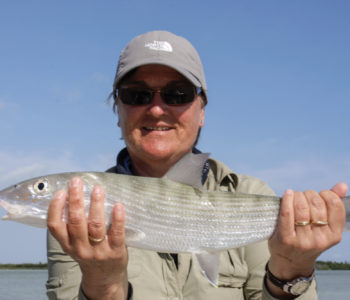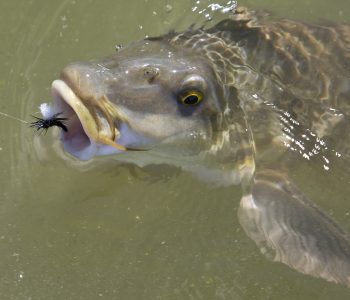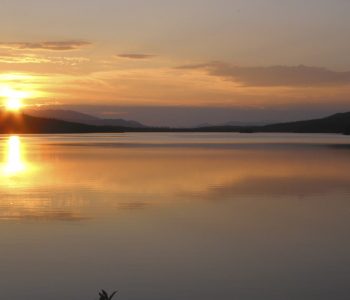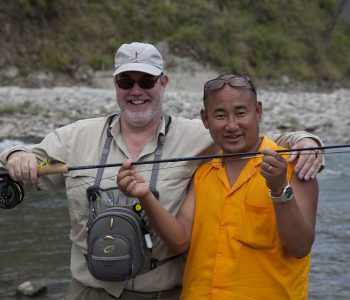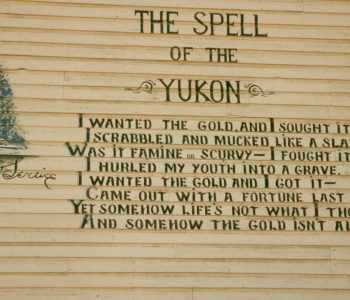
Fishing the west-coast of Newfoundland
During my 1997 visit to Atlantic Canada I fished another 15 different river systems in Newfoundland and once again registered success by using bigger flies then most of the locals did. We were initially greeted by much skepticism and good humor, but began to be taken more seriously before much time had passed. This is not a new experience. The first trip of the 1997 season we made to the wonderful Crabbs River, while we stayed in the Where-Ya-Wannabee” Lodge built on a beautiful spot directly at Pinchgut Lake not far from Corner Brook.
The idea to fish several places had an enormous power of attraction to us. To fish where you wanna be was nothing new to me. We did that a lot in Norway, Sweden and Finland. Our experienced guides, Mark and Barrie, were fanatical catch-and-release fishermen, lending to a very quick meeting of minds. No wonder that we befriended in no time. Janice, Barrie’s wife showed us another side of perfect teamwork. Together with Barrie she managed the lodge and her cooking is like her paintings, just a piece of art. Many of her wonderful water colored landscapes, native culture and portraits beautify the walls of the lodge. It is a nice place to be and feel at home.
In spite of an hour drive to the Crabbs River we fell immediately in love at first sight of this river. This was a river to my heart and a perfect place to start with. While the lodge had been shrouded in fog and soaked by heavy rain, we had the most beautiful weather further south on the river. The fishing was superb and we had a lot of fun, but most importantly the guides were impressed by the success of my large patterns. This was fishing in perfect harmony with nature and while beavers and Moose joined us without any hesitation, Mark and Barrie explained to us more about the Newfoundland wilderness and outdoor life. We really had a great time. Before we reached our car, we chanced upon some local fishermen and engaged in the usual sort of polite, but enjoyable, brief chat. They laughed aloud at the sight of my flies because in their opinion they were useless and much too big: but what they didn’t know, of course, that I just landed my first four fish in just a couple of hours. And so it went: the more fishermen we met the more ribbing I got about my flies; but it all started to change very quickly; for we did very well indeed with those patterns and word gets around. For me it was just a simple question with even a simpler answer. I believe in the flies I tie and fishing techniques I use and confidence is my most important key to success.
 That evening we sat down by open fire and candlelight. With some nice Indian music in the background we listened to the great fishing stories from past.
That evening we sat down by open fire and candlelight. With some nice Indian music in the background we listened to the great fishing stories from past.
The second day I decided to explore downstream away from the main pools. I wanted to see more of this magnificent river, whose shoreline quickly became more rugged with big boulders making fishing quite difficult indeed but also more defiant. The riverbank was hard to follow and with overhanging trees making it a real problem to present your fly where you might prefer. The current was heavy but I could read the river well. Big rocks and a huge slate formation created some wonderful lies and good resting-places for the salmon on their way up. I am sure that many people passed the spot without fishing it, but I absolutely wanted to give it a try. Even Barrie had never fished this place before and we both were very curious what could happen.
The fishing techniques
So I performed a little Norwegian experiment. I changed my popular Bondal fly for one of the patterns from my Pulsar series. I learned this trick while fishing an extremely rugged Norwegian grilse river that became my most favorites of all salmon rivers that I fished upon the north. Here I learned that in high, rough water salmon will often take a bigger fly with a lot of action. The trick worked and another four fish were caught in no time.

Now these Pulsar patterns require a specialized technique in order the flies action becomes most effective. To succeed with these patterns you must know exactly how the fly’s action works. The best way to learn is by dropping the fly in still or slow moving water, then retrieving back at various speeds. Observe the fly closely and remember its action well. I usually start the Pulsar in a dead drift to be sure that the current pushed the fly as close as possible to the place from where I wish to start to fish. This was exactly what I did in Crabbs. I just drop the fly out in the main current on a slack line and used the current to deliver it as close as possible to the slate formation and rocks. This was the only way to get my fly behind the slower water directly beside the rocks. Then I fished it across the current in a retrieve-and-stop action to create the deadly pulsing effect.
I use a similar technique to seduce fish that stay in the middle of the current, so that slack water exist between you and the fish, making proper presentation tricky. With my upstream retrieve, the current will push the fly line to the slower parts of the main current, and this is exactly the place where I give my fly the most action. Fish that held in the middle of the current pursued the fly out of the slick and took it when it reached the outside current of even the dead water. I hooked more then a dozen salmon on Crabbs River this way.
The action of the Pulsar is incredible and the soft rabbit fur gives these patterns a wonderful pulsing effect, but you have to work at it. I am not among those who believe too much action in a salmon fly will disturb the taking mood. Many tried and true traditional European Salmon flies short extremely long wings in an effort to create the same seductive effect.
I consistently experiment with the retrieving speed and technique in wet fly fishing. Some feel the fly should do all the work: okay the popular and very effective riffling hitch is an excellent example. To be honest I did not catch many salmon below the surface when I tried dead-drifting wet fly. Almost all my fish were taken with a manipulated retrieve technique – and it’s the same with fish feeding trout, who seem to love a pulsing effect; so why shouldn’t it work for salmon? I believe many trout techniques work perfectly for salmon: makes sense if you think about it.
What makes the difference
So what makes the Pulsars different? During subsequent trips to the Harry’s river, the Portland Creek feeders and some rivers in the north we did a lot of damage with the Pulsars. In several rivers we regularly scored in pools that had just been vacated by unsuccessful fishermen. In one of the feeders of Portland Creek I managed to hook more fish then anybody else, much to my guide’s delight, but I am certain it has nothing to do with skill and everything to do with solid observation. When I watched the other fishermen they actually presented their flies very well, but they all fished without any action, their flies without any action whatsoever. Their small flies just drifted as a completely dead object in the water. So I fished one of my large Pulsar’s flies in just exactly the opposite way.
At the Dhoon lodge on the Harry’s river I had great success when I landed 4 large salmon in just 2 days. It were the first bigger salmon of the season. The conditions were not easy due to heavy rain and high water levels. I used mainly Pulsars with a nice and powerful upstream retrieve. Even my wife Ina succeeded well. She did not fish as much as I did but with the same techniques she landed two beautiful grilse in less than an hour. Our success did not go unnoticed and during the evening I made a few of my flies for some fishermen who had fished the Fischels River for days without landing a single fish. I explained the technique, and the next day they were off to the races.



